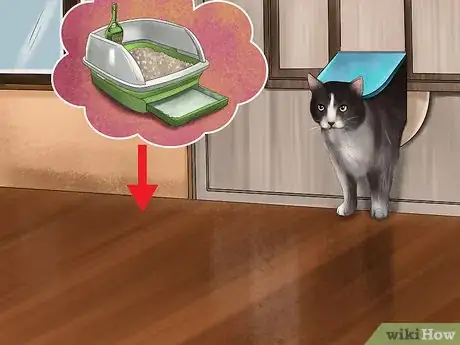This article was co-authored by Lauren Baker, DVM, PhD and by wikiHow staff writer, Jessica Gibson. Dr. Lauren Baker is a Veterinarian and Assistant Scientist at the University of Wisconsin-Madison. With over 10 years in veterinary medicine, she specializes in the concept of “one health,” which uses insights from veterinary medicine to help human medical research. She holds a Ph.D. in Comparative Biomedical Sciences, a Doctor of Veterinary Medicine, an MS in Comparative Biomedical Sciences, and a Bachelor’s degree in Psychology from the University of Wisconsin-Madison.
This article has been viewed 22,982 times.
A cat litter box out in the open is unsightly, but there are ways you can hide or disguise your cat’s litter box that are both attractive and practical. Decide where you'd like to put the litter box so it's out of the way but easy for your cat to get to. Once you've chosen a quiet spot, disguise the litter box by placing it inside a cabinet or storage bench, putting it behind a screen or curtain, or surrounding it with plants.
Steps
Finding a Location
-
1Pick a private space for the litter box. Think of your cat's needs when you decide where to put the litter box. Cats prefer privacy and quiet when they use the litter box, so find a space that's not heavily trafficked in your house. For example, you could place the litter box in the:[1]
- Spare bathroom
- Quiet corner of a storage room
- Closet or unused cabinet
- Basement
- Garage
-
2Give your cat easy access to the box. Make sure your cat can easily access the litter box. Your cat should be able to get to the litter box whenever it needs to and without your assistance. If your cat feels like it can't get to its box or doesn't like where the box is at, it may begin having accidents throughout the house.[2]
- Ensure that your cat doesn't feel like it's trapped when it uses the box. For example, don't put the box in a cabinet inside a closed-off closet or it may feel like it's going to be ambushed.
Advertisement -
3Install kitty doors to give your cat litter box access. If you plan on storing the litter box in a room that you normally keep closed off or in a cabinet or closet, you'll need to keep the doors open or install kitty doors. You can simply cut a space in the bottom of the cabinet or door to give your cat access. Or you can cut a hole and install a little flap that will also give your cat a little extra privacy.[3]
- Ensure that the kitty door is large enough to accommodate your cat. If you have a kitten, anticipate how big it will be as an adult and purchase a kitty door that will be large enough for your cat when it reaches maturity.
-
4Store the litter box away from their food and toys. While it might be tempting to create a little cat space that contains your cat's litter box, toys, food, and water, most cats dislike having their food and water near their litter box. Try to place these away from each other so your cat will use the litter box.[4]
- Your cat will appreciate having a space that it can go to when it feels overwhelmed.
-
5Choose a location that's quiet. You should also take noise into account. Even if you find a space that's out of the way, if there are loud noises, your cat may not like to use the box. For example, while your laundry room might be a pretty quiet space, it may become too loud for your cat if you're running the washer and dryer.
- Consider how your daily activities in the space contribute to the noise. If you have an office that's out of the way and you quietly work there, it may be a good place for your cat.
Disguising the Litter Box
-
1Install the box in a storage bench or dresser. Place the litter box inside a large storage bench or dresser. You can use wood, plastic, or wicker. Cut holes in both ends of the bench or dresser so your cat can easily get in and out.
- The storage bench or dresser should be large enough to easily hold the litter box and give your cat enough space to move around in. Your cat should not have to crouch while inside the furniture, and there should be enough space to provide adequate ventilation.
-
2Modify a cabinet. Try placing the litter box inside a cabinet. You can cut an opening in the existing cabinet so you can still open the doors to get to the litter box. Or install a sliding ledge in the bottom of the cabinet. This will let you pull the litter box out when you need to clean it.
- If you'd like to give your cat the easiest access to the cabinet, consider leaving the bottom of the cabinet open. Just hang a curtain from the top of the cabinet, so it covers the litter box.
-
3Place a screen in front of the litter box. If you'd like to hide the litter box while dividing the room into a space for your cat, set up a large screen in front of the litter box. Or if you'd like something to just hide the litter box, buy a small tri-fold screen that you can put right next to the box.[5]
- Consider using a Japanese shoji screen if you want a large screen. You can find a design that will work with your space while hiding the litter box area.
-
4Buy or build your own litter box disguise. There are dozens of “kitty litter box houses” available online and in pet stores. Many of them also serve as a functional piece of furniture, such as a bench or a wash basin cabinet. Or build a simple one by making a rectangular box with an opening. You can then lower the box over the litter box and simply lift it out of the way when you change or clean the litter.
-
5Surround your litter box with houseplants. Once you've decided where to place the litter box, surround it with large and bushy potted houseplants. These can make the area seem fresh and disguise the litter box. Just ensure that none of the plants are toxic to cats (common toxic plants include charming dieffenbachia, jade, lillies, coleus, and ivy).[6]
- You can even buy large potted plants that have a hidden litter box in the base of the pot. There's an opening for your cat to get in and use the box.
Warnings
- The odor in an enclosed space can build up fast, no matter how often you scoop the litter. You should scoop the litter box daily, and also use a deodorizing cat litter or pine-based litter. Alternatively, place a small bowl of white vinegar in the same room as the litter box to absorb odors. Just don't place the bowl right next to the litter box, as the strong smell could deter your cat.⧼thumbs_response⧽
References
- ↑ http://www.animalplanet.com/pets/best-place-to-put-a-litter-box/
- ↑ http://www.animalplanet.com/pets/best-place-to-put-a-litter-box/
- ↑ http://www.petplace.com/cats/six-places-to-hide-your-litter-box/page1.aspx
- ↑ http://www.animalplanet.com/pets/best-place-to-put-a-litter-box/
- ↑ http://www.hillspet.com/en/us/cat-care/resources/diy-litter-box-enclosures
- ↑ http://www.petplace.com/cats/six-places-to-hide-your-litter-box/page1.aspx
About This Article
To hide your cat’s litter box, first choose a quiet, private location in your house to put the box, such as a spare bathroom or storage room that your cat will feel comfortable in. Once you decide on a room, you can disguise your litter box by placing it in a large cabinet and removing one of the cabinet doors. If you’d like, you can put up a curtain to further hide the litter box, while allowing your cat to go in and out as it pleases. Alternatively, you can hide your litter box by putting decorations in front of it, such as a screen room divider or house plants. To learn how to build your own kitty litter box house, read more from Veterinary co-author!





































































